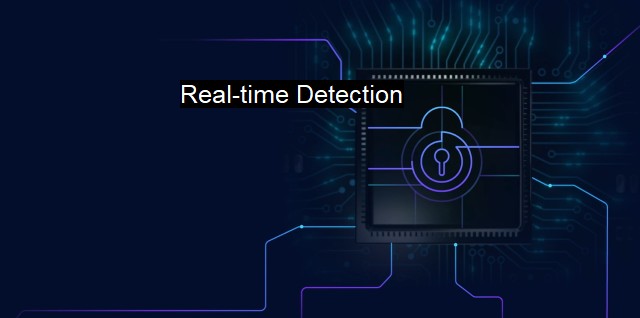What is Real-time Detection?
Unleashing the Power of Real-time Detection in Cybersecurity: A Critical Technique for Identifying and Responding to Threats
Real-time detection is a crucial aspect of cybersecurity and antivirus solutions designed to identify and avert possible security threats instantaneously as and when they occur. Real-time detection in cybersecurity is like an ever-awake, vigilant soldier continuously combating potential threats seeking to infiltrate the network and it plays an integral role in the dynamic world of cybersecurity.Cybersecurity involves the implementation of measures to protect a computer system or network from being affected by threats, damage, disruption, or unauthorized access. Antivirus software is one of those protective measures established to avert, detect, and remove malicious software, which is designed to harm the system. Therefore, real-time detection is one important measure implemented by antivirus solutions to ensure immediate isolation and extraction of such threats.
Real-time detection operates primarily through continuous system scans. It runs round-the-clock, inspecting files and applications while comparing them against a known database of threats. It is akin to having a real-time shield that constantly guards your system, allowing you to neutralize threats before they even get a chance to penetrate your network. This works for both incoming and outgoing files, providing full-circle protection.
The immediate detection of threats mitigates risk exposure, reduces the potential impact on businesses, and improves their resilience against cyber-attacks. Without real-time detection, businesses will need to regularly and completely scan their systems to identify and curb threats at the risk of affecting business operations. Having an operating system being actively scanned for potential threats affords both more protection and less business disruption.
In the fast-paced world of cybersecurity, where new threats emerge every second, relying on regular or periodic scans poses serious risks. Attackers have sharpened their skills, powers, and modes of attack. In some cases, threats may imbed themselves within the system, lying low before finally striking– which might be devastating. The speed with which a threat can bring down an entire network calls for the need to continuously monitor and instantly neutralize them.
Real-time detection also significantly impacts the antivirus solution's effectiveness. The more advanced antivirus software offers built-in real-time detection and uses complex algorithms to identify malware even before it starts damaging a computer's system. This proactive detection is much more effective compared to only cleaning up after the infection occurred.
It exceeds the potential of traditional antivirus capabilities as it monitors network traffic and user behavior in real-time - identifying all anomalies and mitigating accordingly. It can discover direct threats, such as viruses and worms, as well as indirect attacks, such as phishing attempts and ransomware. Real-time detection is often considered the way to effectively combat zero-day attacks - threats that exploit security vulnerabilities on the same day those vulnerabilities become known.
Real-time detection is not without its challenges. It requires a significant amount of computing resources to continuously scan and monitor network activity. it can sometimes return false positives, making it overly keen at times. Despite these challenges, the benefits of real-time detection in cybersecurity outweigh these limitations.
Real-time detection in antivirus and cybersecurity solutions is a necessity in today's digital world. It is a 'must-have', and not a 'good to have', feature. Its proactive, rather than reactive, approach allows businesses and individuals to prevent data breaches, mitigate damages, and maximize up-time, contributing to a healthy digital environment. in the never-ending, fast-paced battle against cyber threats, real-time detection is a valuable tool in our cybersecurity arsenal.

Real-time Detection FAQs
What is real-time detection in cybersecurity?
Real-time detection refers to the ability of antivirus software to detect and respond to a cyber attack as it happens in real-time. It involves the continuous monitoring of system activity to detect and respond to any potential threats as they occur.How does real-time detection work in antivirus software?
Real-time detection in antivirus software involves various techniques, such as signature-based detection, behavioral analysis, and heuristic analysis. Signature-based detection involves comparing a file's signature with a database of known malware signatures, while behavioral analysis observes a file's behavior to identify any suspicious activity. Heuristic analysis involves analyzing a file's code to identify any potential threats. All of these techniques work together to detect and respond to cyber threats in real-time.What are the benefits of real-time detection in cybersecurity?
The benefits of real-time detection in cybersecurity are numerous. It allows for the immediate detection and response to cyber threats, reducing the potential for damage and data loss. It also provides a more proactive approach to cybersecurity, helping to prevent cyber attacks before they occur. Additionally, real-time detection can help organizations meet compliance requirements and protect their reputation.Is real-time detection sufficient for protecting against all cyber threats?
While real-time detection is an essential component of cybersecurity, it may not be sufficient on its own to protect against all cyber threats. Cybercriminals are constantly evolving and developing new ways to bypass security measures. Thus, it's essential to supplement real-time detection with other security measures, such as firewalls, antivirus software, and employee training. A comprehensive cybersecurity strategy that incorporates multiple layers of protection is the best approach to safeguard against cyber threats.| | A | | | B | | | C | | | D | | | E | | | F | | | G | | | H | | | I | | | J | | | K | | | L | | | M | |
| | N | | | O | | | P | | | Q | | | R | | | S | | | T | | | U | | | V | | | W | | | X | | | Y | | | Z | |
| | 1 | | | 2 | | | 3 | | | 4 | | | 7 | | | 8 | | |||||||